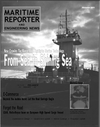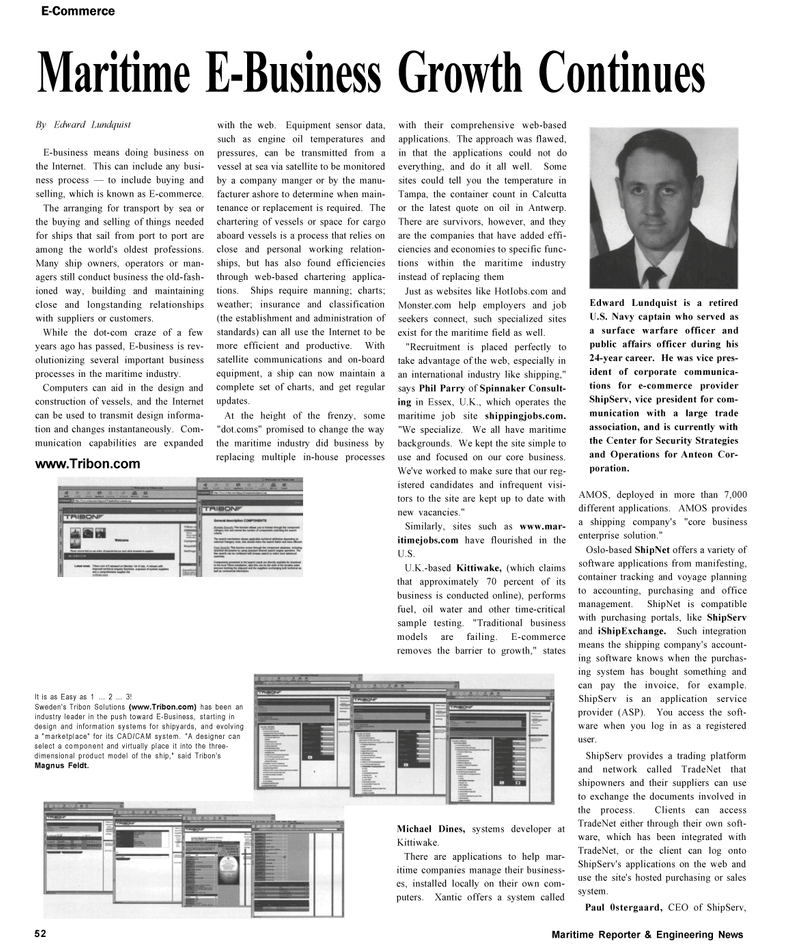
Page 52: of Maritime Reporter Magazine (November 2002)
Read this page in Pdf, Flash or Html5 edition of November 2002 Maritime Reporter Magazine
E-Commerce
Maritime E-Business Growth Continues
Edward Lundquist is a retired
U.S. Navy captain who served as a surface warfare officer and public affairs officer during his 24-year career. He was vice pres- ident of corporate communica- tions for e-commerce provider
ShipServ, vice president for com- munication with a large trade association, and is currently with the Center for Security Strategies and Operations for Anteon Cor- poration.
AMOS, deployed in more than 7,000 different applications. AMOS provides a shipping company's "core business enterprise solution."
Oslo-based ShipNet offers a variety of software applications from manifesting, container tracking and voyage planning to accounting, purchasing and office management. ShipNet is compatible with purchasing portals, like ShipServ and iShipExchange. Such integration means the shipping company's account- ing software knows when the purchas- ing system has bought something and can pay the invoice, for example.
ShipServ is an application service provider (ASP). You access the soft- ware when you log in as a registered user.
ShipServ provides a trading platform and network called TradeNet that shipowners and their suppliers can use to exchange the documents involved in the process. Clients can access
TradeNet either through their own soft- ware, which has been integrated with
TradeNet, or the client can log onto
ShipServ's applications on the web and use the site's hosted purchasing or sales system.
Paul 0stergaard, CEO of ShipServ,
Michael Dines, systems developer at
Kittiwake.
There are applications to help mar- itime companies manage their business- es, installed locally on their own com- puters. Xantic offers a system called with their comprehensive web-based applications. The approach was flawed, in that the applications could not do everything, and do it all well. Some sites could tell you the temperature in
Tampa, the container count in Calcutta or the latest quote on oil in Antwerp.
There are survivors, however, and they are the companies that have added effi- ciencies and economies to specific func- tions within the maritime industry instead of replacing them
Just as websites like HotIobs.com and
Monster.com help employers and job seekers connect, such specialized sites exist for the maritime field as well. "Recruitment is placed perfectly to take advantage of the web, especially in an international industry like shipping," says Phil Parry of Spinnaker Consult- ing in Essex, U.K., which operates the maritime job site shippingjobs.com. "We specialize. We all have maritime backgrounds. We kept the site simple to use and focused on our core business.
We've worked to make sure that our reg- istered candidates and infrequent visi- tors to the site are kept up to date with new vacancies."
Similarly, sites such as www.mar- itimejobs.com have flourished in the
U.S.
U.K.-based Kittiwake, (which claims that approximately 70 percent of its business is conducted online), performs fuel, oil water and other time-critical sample testing. "Traditional business models are failing. E-commerce removes the barrier to growth," states
It is as Easy as 1 ... 2 ... 3!
Sweden's Tribon Solutions (www.Tribon.com) has been an industry leader in the push toward E-Business, starting in design and information systems for shipyards, and evolving a "marketplace" for its CAD/CAM system. "A designer can select a component and virtually place it into the three- dimensional product model of the ship," said Tribon's
Magnus Feldt.
By Edward Lundquist
E-business means doing business on the Internet. This can include any busi- ness process — to include buying and selling, which is known as E-commerce.
The arranging for transport by sea or the buying and selling of things needed for ships that sail from port to port are among the world's oldest professions.
Many ship owners, operators or man- agers still conduct business the old-fash- ioned way, building and maintaining close and longstanding relationships with suppliers or customers.
While the dot-com craze of a few years ago has passed, E-business is rev- olutionizing several important business processes in the maritime industry.
Computers can aid in the design and construction of vessels, and the Internet can be used to transmit design informa- tion and changes instantaneously. Com- munication capabilities are expanded www.Tribon.com with the web. Equipment sensor data, such as engine oil temperatures and pressures, can be transmitted from a vessel at sea via satellite to be monitored by a company manger or by the manu- facturer ashore to determine when main- tenance or replacement is required. The chartering of vessels or space for cargo aboard vessels is a process that relies on close and personal working relation- ships, but has also found efficiencies through web-based chartering applica- tions. Ships require manning; charts; weather; insurance and classification (the establishment and administration of standards) can all use the Internet to be more efficient and productive. With satellite communications and on-board equipment, a ship can now maintain a complete set of charts, and get regular updates.
At the height of the frenzy, some "dot.coms" promised to change the way the maritime industry did business by replacing multiple in-house processes 52 Maritime Reporter & Engineering News

 51
51

 53
53
